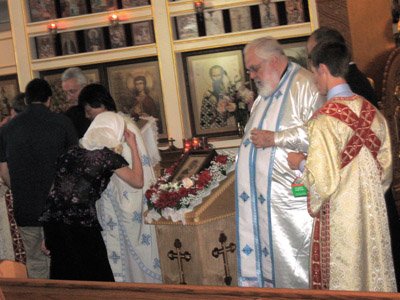We are all familiar with
”
icons
”
today, either on a computer screen or in popular culture. These
symbols are shortcuts to recognition.
But there is a much older type of icon, associated with the
early centuries of Christianity. These are flat, stylized pictures
created in wood, paper, stone or other materials that are
considered helpful aids to devotion.
We are all familiar with “icons” today, either on a computer screen or in popular culture. These symbols are shortcuts to recognition.
But there is a much older type of icon, associated with the early centuries of Christianity. These are flat, stylized pictures created in wood, paper, stone or other materials that are considered helpful aids to devotion. They represent Christ or a saint and are venerated by millions of members of the Eastern Orthodox churches and other Christians who believe that they are powerful channels of grace from God to faithful believers.
San Jose’s St. Basil the Great Greek Orthodox Church (1630 Bose Lane) was visited by a famous icon from Hawaii on Aug. 16. This small picture (7 inches by 9 inches) of the Blessed Virgin Mary holding the infant Jesus has a short but interesting history.
Myrrh is a fragrant gum resin that comes from certain trees in the Mideast. There seems to be a tradition of icons that begin to miraculously exude this substance, often in the form of teardrops that possess the fragrance of roses. The icon visiting St. Basil is an exact replica of a famous myrrh-streaming icon in Montreal of the Theotokos (“Mother of God”) of Inveron. It is a paper print mounted on wood, manufactured in Russia and purchased in Toronto by a priest who gave it to a Russian Orthodox believer in Honolulu in 2007.
In October of that year, the owner, Nectarios, noticed the sweet smell of roses in his study. An investigation caused him to discover this icon was exuding small drops of myrrh, coming from the Virgin’s eyes and dripping down the panel.
He later took it to his parish church where it continued to emit this sweet-smelling substance. It became quite famous in Hawaii, and a large number of visitors from all Christian traditions have come to visit the icon, “feeling the grace of God” in its presence. Some days the icon is dry and others it is completely covered in myrrh. Yet it continuously gives off the scent of roses.
In June 2008, the Holy Myrrh-Streaming Hawaiian Inveron Icon was “officially recognized by Archbishop Kyrill of the Russian Orthodox Church as miraculous and genuine and given the blessing to travel to churches of Holy Orthodoxy.” At St. Basil Sunday, the icon was introduced to the parish with a procession at the 9:30 a.m. Divine Liturgy. Surrounded by priests and robed assistants, it was ushered with clouds of incense down the center aisle and placed on a special stand before the iconostasis (screen in front of the altar).
The morning’s sermon explained that the point of the icon’s streaming was to show the love of Mary, Mother of God. She is considered the “Mediatrix” between God and humans, and the myrrh from the icon has reportedly caused great miracles in Hawaii and elsewhere.
Following the worship service, Nectarios, the original owner of the icon, spoke briefly about it. He assured everyone that the streaming was no trick, but a genuine miracle and told of some miraculous cures attributed to the icon, suggesting the tears are “a reaction to our sinful ways.”
Afterward, members of the congregation lined up to reverently kiss the icon and receive a blessing from priests who anointed them with myrrh collected from the painting. Parishioners took the Q-tips used for this procedure home in sealed small plastic bags.
The Greek Orthodox Church is one of a family of churches originating in the Mediterranean region and Eastern Europe that today have more than 200 million members.
They share ancient traditions and separated from Western Christianity in the 11th century over issues of belief. Today there are more than six million Eastern Orthodox believers in the United States, divided among separate churches usually named for the country from which members immigrated (Russian Orthodox, Serbian Orthodox, etc.).
For more information about the icon, call St. Basil’s Church at (408) 268-3214.












